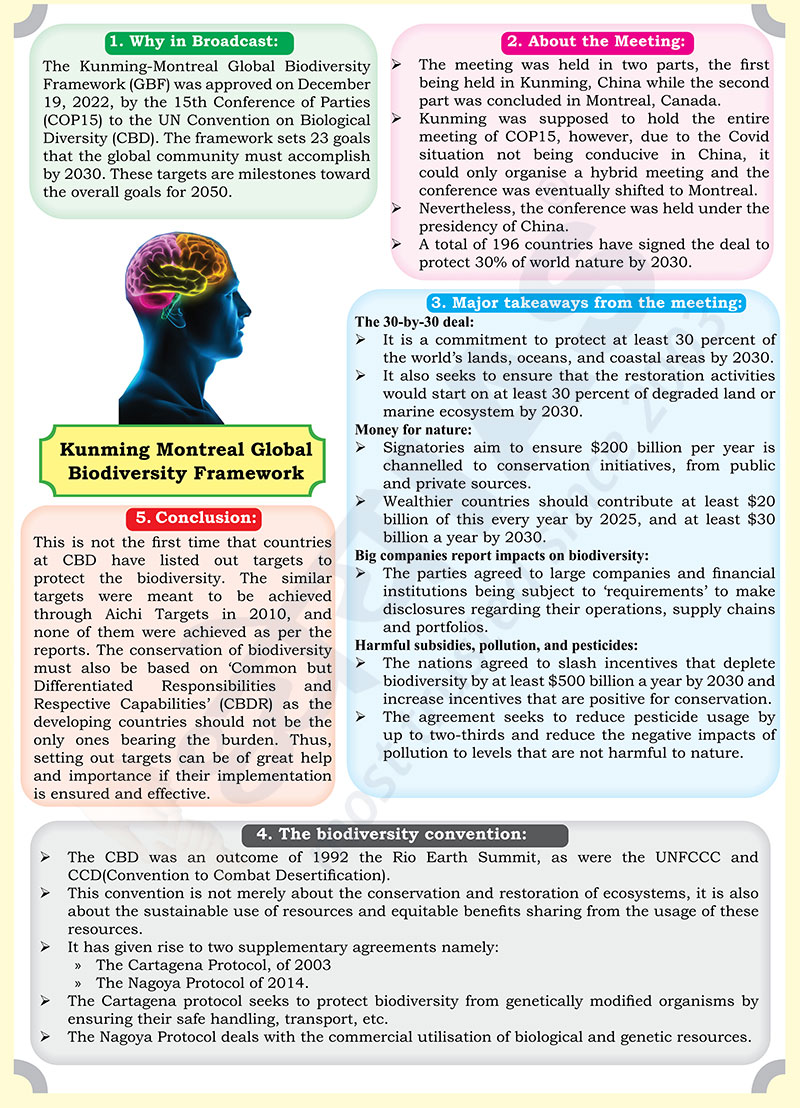Why in Broadcast?
- The Kunming-Montreal Global Biodiversity Framework (GBF) was approved on December 19, 2022, by the 15th Conference of Parties (COP15) to the UN Convention on Biological Diversity (CBD). The framework sets 23 goals that the global community must accomplish by 2030. These targets are milestones toward the overall goals for 2050.
About the Meeting:
- The meeting was held in two parts, the first being held in Kunming, China while the second part was concluded in Montreal, Canada.
- Kunming was supposed to hold the entire meeting of COP15, however, due to the Covid situation not being conducive in China, it could only organise a hybrid meeting and the conference was eventually shifted to Montreal.
- Nevertheless, the conference was held under the presidency of China.
- A total of 196 countries have signed the deal to protect 30% of world nature by 2030.
Major takeaways from the meeting:
The 30-by-30 deal:
- It is a commitment to protect at least 30 percent of the world’s lands, oceans, and coastal areas by 2030.
- It also seeks to ensure that the restoration activities would start on at least 30 percent of degraded land or marine ecosystem by 2030.
Money for nature:
- Signatories aim to ensure $200 billion per year is channelled to conservation initiatives, from public and private sources.
- Wealthier countries should contribute at least $20 billion of this every year by 2025, and at least $30 billion a year by 2030.
Big companies report impacts on biodiversity:
- The parties agreed to large companies and financial institutions being subject to ‘requirements’ to make disclosures regarding their operations, supply chains and portfolios.
Harmful subsidies, pollution, and pesticides:
- The nations agreed to slash incentives that deplete biodiversity by at least $500 billion a year by 2030 and increase incentives that are positive for conservation.
- The agreement seeks to reduce pesticide usage by up to two-thirds and reduce the negative impacts of pollution to levels that are not harmful to nature.
The biodiversity convention:
- The CBD was an outcome of 1992 the Rio Earth Summit, as were the UNFCCC and CCD(Convention to Combat Desertification).
- This convention is not merely about the conservation and restoration of ecosystems, it is also about the sustainable use of resources and equitable benefits sharing from the usage of these resources.
- It has given rise to two supplementary agreements namely:
- The Cartagena Protocol, of 2003
- The Nagoya Protocol of 2014.
- The Cartagena protocol seeks to protect biodiversity from genetically modified organisms by ensuring their safe handling, transport, etc.
- The Nagoya Protocol deals with the commercial utilisation of biological and genetic resources.
Conclusion:
- This is not the first time that countries at CBD have listed out targets to protect the biodiversity. The similar targets were meant to be achieved through Aichi Targets in 2010, and none of them were achieved as per the reports. The conservation of biodiversity must also be based on ‘Common but Differentiated Responsibilities and Respective Capabilities’ (CBDR) as the developing countries should not be the only ones bearing the burden. Thus, setting out targets can be of great help and importance if their implementation is ensured and effective.
























